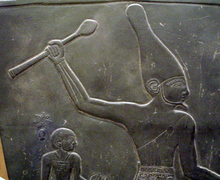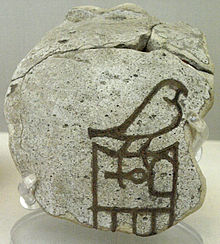Menes
![]()
The title of this article is ambiguous. For other meanings, see Menes (disambiguation).
![]()
This article or section needs revision. More details should be given on the discussion page. Please help improve it, and then remove this tag.
Menes (ancient Greek Μῖνα), who is said to have ruled as an ancient Egyptian king (pharaoh) around 3000 BC, is usually named as the founder of the 1st dynasty in the early dynastic period according to the later tradition of the supposed unification of the empire. The evaluation as "first unifier of the empire" is unhistorical, since already his predecessors understood themselves as rulers of Upper and Lower Egypt in the context of the unification festival.
Among some successors of Menes a repeated unification of the empire is documented. Since the first stable connections are only attested at the end of the 2nd Dynasty, Egyptology does not see Menes as the final unifier of the empire. For example, the Egyptologists Wolfgang Helck and Jochem Kahl refer to the role mythologically assigned to him as the "first empire unifier" in the context of the annual royal annals first introduced under Menes.
Historical lore
According to Herodotus and Manetho, the city of Memphis (Egyptian Men-nefer, "place of good"; original name Inebu-hedj, "White Wall") was founded under Menes after the Nile had been split and an artificial island created. Manetho adds to this that Menes perished at the hands of a ross-shaped river monster (hippopotamus). According to Manetho, he also led a military expedition abroad and was victorious there.
Menes, according to Manetho, reigned 62 years (so Africanus), 60 years (Eusebius), or 30 years (Armenian version of Eusebius).
Equivalences with contemporary rulers
Egyptologists and historians still find it difficult to identify Menes with any of the early dynastic rulers. The reason for this is the fact that the Egyptian rulers from the Predynastic period to the middle of the 1st Dynasty are always named only with their Horus name on clay seals, ivory plaques, stone vessels and reliefs.
In the king lists, however, they appear with their birth name, which since the 4th Dynasty is written in a cartouche. This circumstance leads many scholars to ask where, for example, Ramesside scribes obtained the cartouche names for the first four rulers when compiling their king lists, since at that time only the name of Horus was inscribed in public documents.
In the past, many attempts were made to identify Menes with early dynastic rulers, especially the kings Narmer and Hor Aha became the focus of research. Egyptologists such as William Matthew Flinders Petrie, Walter Bryan Emery and Wolfgang Helck attempted in publications a comparison of the theses that speak for or against Narmer or Aha as historical models of Menes. In doing so, the researchers concentrated especially on the hieroglyph Mn, which appears equally under both rulers on clay seals and ivory tablets. For some time now, most Egyptologists have regarded the hieroglyph Mn as a personal name, which is why it is most likely a prince's name due to its epigraphic position on seals and plaques.
Equation with Narmer
Narmer is depicted on ostentatious palettes with the white crown of the south (Ta-seti) and the red crown of the north. At his time, therefore, Egypt seems to have been already united. - Against this argument speaks the fact that Narmer had only successfully completed a military offensive against Lower Egypt, of course he had himself depicted as victor with the royal insignia of his defeated opponent. But this does not mean that he must have been already commonly accepted autocrat of Egypt.
On a sceptre pommel from Hierakonpolis Narmer is depicted celebrating the festival of Sed. In front of him the divine Reput shrine is built. Some Egyptologists like Percy E. Newberry see in the "Reput cult image" the representation of a goddess or the princess Neithotep, which led them to interpret this scene as a wedding ceremony. - In this context, however, Werner Kaiser and Günter Dreyer pointed to the fact that it was not a goddess but a ritual portrait.
Equation with aha
This thesis is supported by the Cairo Stone, whose inscription gives hints that between Aha and king Djer another ruler must have ruled for a very short time. Since king Djer is called "Iteti" on the Cairo Stone, in this case the name "Meni" would remain only for Aha, since "Teti" seems to be an independent ruler. - Against this point speaks that the Cairo Stone is to be regarded with the greatest caution with regard to the mention of cartouche names, because the mere mention of cartouche names is a serious anachronism, since in the lifetime of Aha this titulature was unknown.
| On an ivory tablet from the tomb of Aha near Abydos is one of the oldest written representations of the hieroglyphic
(mn) engraved directly opposite the royal serech of Aha. It is within a triple ornamental frame, together with a predecessor form of the secondary name. |
Ivory tablets from Ahaz's tomb are the first to mention the hieroglyphic symbol Rnpt (Renpet, "year"), represented by a bald palm frond. Thus, the first calendar entries in Egyptian history have survived on Ahaz's labels. This could have provided sufficient reason for the Egyptians of later epochs to regard Aha as a "founder of the annals" and thus the initiator of Egyptian historiography. - This is contradicted by the fact that clay seals from the tomb of Queen Meritneith, the wife of King Wadji, list the names "Narmer", "Aha", "Djer" and "Wadji". Thus, the line of rulers does not begin with Aha at all, so the latter was not considered the first regent of Egypt in Meritneith's time. One should also not forget that the above mentioned Renpet-sign as a symbol for "year" only gained calendrical importance in later times when it was about the recording of administrative data for the purpose of tax collection and ancestor honor.
In Sakkara is the mastaba p. 3357, in which fragments of vessels and ivory labels bearing the name of Aha have been found. This mastaba is one of the oldest of its kind, and Sakkara was the royal necropolis of Memphis. Since no ruler from the time before Aha appears here and Menes is called the founder of Memphis, it seems obvious that only Aha can be responsible for the foundation of Memphis and therefore would have to be identical with Menes. - Against this point speaks the fact that the founder of a capital city must not necessarily have been buried in the local necropolis. King Chasechemui for example (2nd Dynasty) ruled in Hierakonpolis and Memphis, but was buried in Abydos.

Portrait of the Narmer

Horus name of the Aha
Questions and Answers
Q: Who was Menes and when did he live?
A: Menes was a pharaoh of the first dynasty of ancient Egypt who lived around 3100-3000 BC.
Q: What was Menes known for achieving?
A: Menes is known for bringing together Upper and Lower Egypt to make an empire.
Q: What was the Pschent or double crown that Menes wore?
A: The Pschent or double crown that Menes wore was made up of the white crown of Upper Egypt and the red crown of Lower Egypt.
Q: Where did Menes build the capital of his empire?
A: Menes built the city of Memphis and made it the capital of his empire.
Q: Is there strong evidence to support the existence of Menes as a pharaoh?
A: There is little evidence for the existence of Menes as a pharaoh, although there is a lot of archaeological evidence for a pharaoh named Narmer.
Q: Who are the pharaohs that Menes is believed to be either one of?
A: Menes is believed to be either Narmer, the pharaoh before Narmer, or Hor-Aha, who ruled after him.
Q: What is the significance of the image of Menes holding an ankh on the frieze on the south wall of the U.S. Supreme Court building?
A: The significance of the image of Menes holding an ankh on the frieze on the south wall of the U.S. Supreme Court building is unknown, as it is not clear why the figure was included in the design.
Search within the encyclopedia